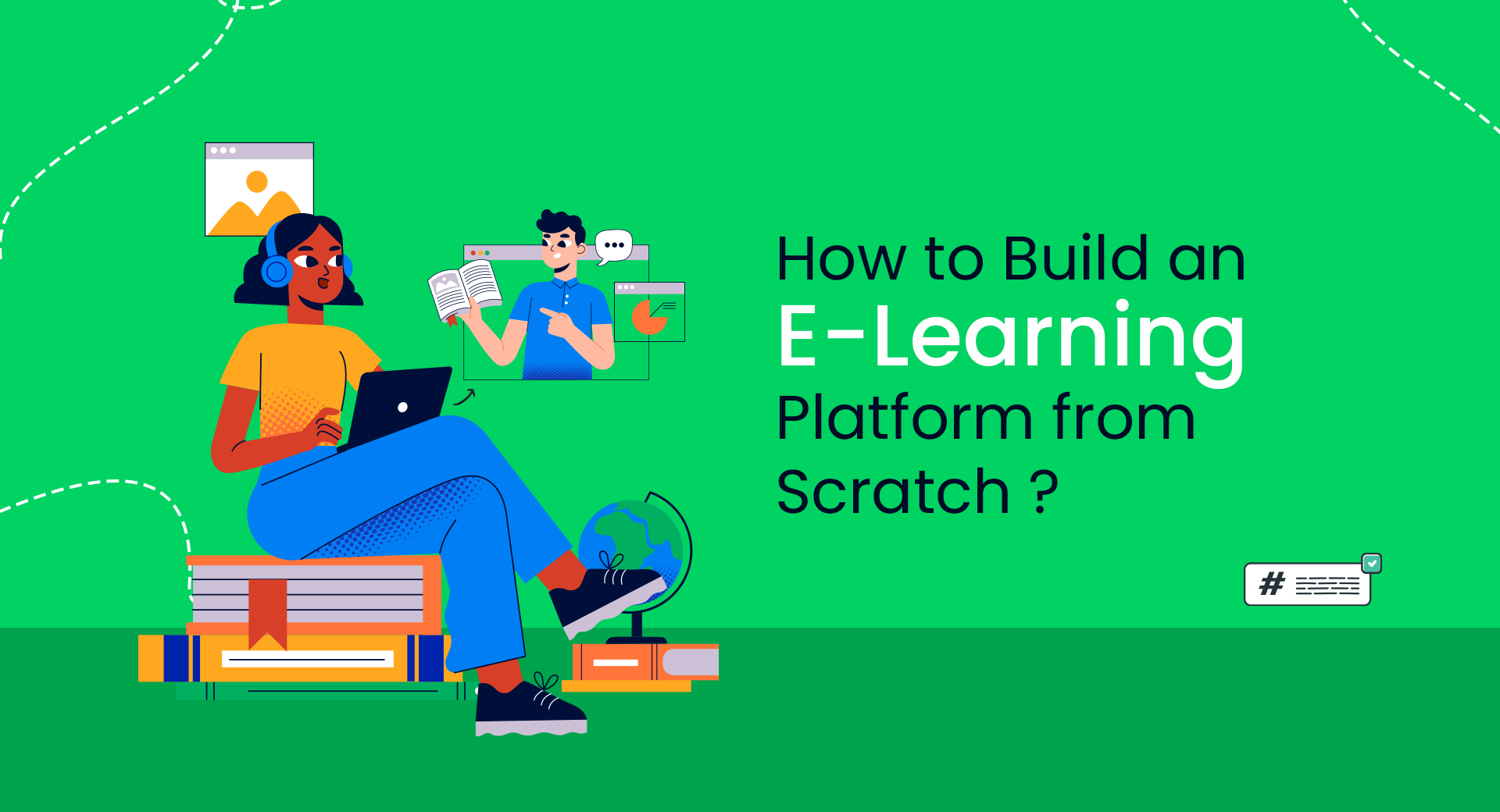Key Highlights
- Building an e-learning platform from scratch offers a lucrative opportunity in the global e-learning market, which is projected to reach $300 billion by 2025.
- An e-learning platform provides a flexible and accessible online learning experience for users worldwide.
- The success of platforms like Udemy and Coursera highlights the importance of user experience and learning management systems.
- To build a successful e-learning platform, it is crucial to identify your target audience, conduct market research, and focus on creating a unique learning experience.
- Developing an e-learning platform involves conceptualizing the idea, choosing the right technology stack, designing a user-friendly interface, and developing core features.
Introduction
The Covid-19 crisis has had a significant impact on various industries, forcing businesses to adapt and find new ways to operate. One industry that has experienced significant growth during this time is e-learning. With people around the world looking for ways to occupy their minds while being indoors, online learning has become a popular choice. As a result, the global e-learning market is booming, offering a lucrative business opportunity for those interested in building their e-learning platform. The size of the global e-learning market is forecasted to reach 370 billion U.S. dollars by 2026, making it a promising industry for aspiring startups and entrepreneurs.
In this blog, we will guide you on building an e-learning platform from scratch. We’ll cover key highlights, types of platforms, successful models, features of top platforms like Udemy and Coursera, and success factors. Before building your platform, it’s crucial to identify your target audience, define your content niche, and focus. You’ll also need to gather essential equipment and software for creating your e-Learning platform.
Develop your e-learning platform with our step-by-step guide: conceptualize your idea, choose the right tech stack, design a user-friendly interface, and develop core features. Test for quality, launch, and market effectively. Exploring monetization strategies for your e-Learning platform, including subscription models, affiliate marketing, and sponsorships. Stand out by updating content regularly and integrating interactive elements and gamification.
Additionally, by the end of this blog, you will have a comprehensive understanding of how to build an e-learning platform from scratch and the key factors to consider for success in the e-learning market. So let’s dive in and explore the world of online education!
Understanding e-learning Platforms
e-learning platforms, also known as online education platforms, have changed the way people learn by providing accessible and flexible learning experiences. These platforms enable students to learn without the need to physically attend a traditional classroom, offering the freedom to progress at their own pace.
One of the key components of e-learning platforms is the learning management system (LMS), which provides a centralized platform for managing course content, student enrollment, and tracking progress. LMSs are essential in delivering a seamless learning experience, ensuring that students have access to the right resources and can track their progress effectively.
By leveraging the power of technology and the internet, e-learning platforms have opened up a world of opportunities for learners of all ages and backgrounds, including educational institutions. Whether it’s acquiring new skills, pursuing higher education, or exploring personal interests, e-learning platforms provide a wide range of courses and resources to cater to individual needs.
Defining e-learning and Its Importance
e-learning, also known as electronic learning, refers to education delivered through digital devices such as computers, tablets, and smartphones. It enables students to learn anytime, anywhere, without the need to physically attend a traditional classroom.
The importance of e-learning in today’s fast-paced world is clear. It provides advantages like flexibility, accessibility, and personalized learning experiences. e-learning offers students the flexibility to learn at their own pace, explore topics of interest, and master challenging concepts. It removes location and time barriers, providing education opportunities for those with diverse schedules and commitments.
Additionally, e-learning provides a platform for continuous learning and skill development, enabling individuals to stay relevant in their fields and adapt to the ever-changing demands of the job market. It also offers the opportunity for individuals to explore new subjects and interests, broadening their knowledge and horizons.
In summary, e-learning plays a crucial role in providing accessible and flexible education to individuals worldwide, empowering them to pursue their learning goals and unlock their full potential.
Different Types of E-learning Platforms
E-learning platforms come in various forms, catering to different learning needs and preferences. Here are some of the different types of e-learning platforms:
- Virtual Classrooms: These platforms aim to replicate the traditional classroom experience in an online setting, allowing students and teachers to interact in real-time through video conferencing, chat features, and collaborative tools.
- Learning Platforms: These platforms provide a wide range of courses and resources across different subjects and disciplines. They often offer a mix of self-paced learning, interactive content, and assessments to facilitate effective learning experiences.
- Massive Open Online Courses (MOOCs): MOOCs are designed to offer courses to a large number of participants worldwide. They typically provide free access to course materials and offer optional certifications upon completion.
- Corporate Training Platforms: These platforms focus on providing training and development solutions to businesses and organizations. They offer customized courses and learning experiences tailored to the specific needs of employees, helping them acquire new skills and stay updated in their respective industries.
Further, by catering to different learning needs and preferences, these e-learning platforms provide individuals with a wide range of options to engage in online education and pursue their learning goals.
Here’s an article on User-Centric Design Strategies for Conversions, check it out!
Exploring Successful e-Learning Models
Analyzing successful e-learning models can provide valuable insights for building your platform. One such successful model is Udemy, an e-learning platform that has established itself as a leading online learning platform. Udemy offers a wide range of courses on various subjects, catering to individuals looking to enhance their skills or learn something new.
Another successful model is Coursera, which partners with top universities and institutions to offer high-quality online courses. Coursera’s business model focuses on providing courses that lead to certifications and degrees, making it an attractive option for individuals seeking formal education.
Brandon Hall, a research firm, has identified successful e-learning models focusing on user experience, engaging content, and effective delivery for a positive learning experience.
Key Features of Top e-Learning Platforms
Top e-learning platforms feature a user-friendly interface that is easy to navigate and responsive across devices. Unique design elements enhance the user experience, while customizable features like personalized learning paths and progress tracking create tailored experiences. Interactive elements such as quizzes and multimedia content boost engagement and knowledge retention. Collaboration tools like discussion forums promote community interaction among learners, making them essential features for any successful e-learning website.
Analyzing the Success Factors of Udemy and Coursera
Udemy and Coursera excel in the e-learning market due to their diverse course offerings, engaging video content, and user-friendly interfaces. Additionally, these platforms prioritize user experience by offering features like progress tracking and personalized recommendations, setting a high standard for e-learning platforms.
Check out an article about AI & Machine Learning.

Preliminary Considerations Before Building Your Platform
Before creating an e-learning platform, consider key factors. Define your target audience to guide design, content, and features. Conduct market research to grasp industry trends, competition, and requirements. Establish your website’s vision, goals, objectives, and unique selling points to differentiate in the market. These steps form a solid foundation for an effective e-learning platform that meets your audience’s needs and offers insights for future enhancements based on feedback.
Identifying Your Target Audience
Understanding your e-learning platform’s audience is vital. Identify demographic traits like age, gender, and education to tailor your content. Consider their learning goals and styles. Also, assess if they are beginners or professionals. By knowing your audience, you can design engaging courses suited to their needs.
Deciding on Content Niche and Focus
Deciding on your e-learning platform’s niche is crucial. Identify market demand and gaps, consider audience needs, and offer unique courses. Stay ahead by exploring emerging fields. Aligning content with audience interests attracts and retains learners.
What You Need to Get Started
To build an e-learning platform, you need computers, cameras, and recording equipment for content creation. Choose the right technology stack, web development tools, and software for a strong foundation. Expertise in mobile app development is crucial if offering a mobile app.
Essential Equipment and Software
When creating an e-learning platform, the right equipment and software are essential for high-quality content. This includes computers, cameras, microphones, recording tools, an authoring tool for interactive course materials, and a suitable tech stack with programming languages and tools. For mobile apps, use app development tools for a seamless user experience. Invest in professional e-learning equipment and software.
Gathering Your Initial Content Resources
Before launching your e-learning platform, gather initial content resources and develop engaging course content for your target audience. Create well-structured slide presentations, video lectures, quizzes, and assignments to deliver desired outcomes. Supplement courses with ebooks, articles, expert videos, and tutorials for a comprehensive learning experience. Quality content is crucial to your platform’s success. Invest time into developing user-centric content, as important as the e-learning application development phase.
An article about Data Engineers vs. Machine Learning Engineers might be of interest to you.
Step-by-Step Guide to Developing Your e-Learning Platform
Developing an e-learning platform requires careful planning and execution. Following a step-by-step guide can help ensure a successful development process.
Step 1: Conceptualizing Your Platform Idea
Conceptualize your e-learning platform by defining its vision, purpose, target audience, and business model. Differentiate your platform with unique features and content to create a positive learning experience. Consider revenue streams and pricing strategies to build a successful e-learning platform.
Step 2: Choosing the Right Technology Stack
Choosing the right technology stack is crucial for building a robust e-learning platform. Consider scalability, security, and compatibility. Popular web development technologies include HTML, CSS, JavaScript, React, and Angular. Backend development may involve Python, Ruby, or PHP with frameworks like Django or Laravel. Also, consider database technologies, hosting platforms, and content management systems to support your platform’s functionality. Choose wisely for a stable and efficient development process.
Step 3: Designing a User-Friendly Interface
Creating a user-friendly interface on your e-learning platform is crucial for a seamless experience. Prioritize ease of navigation, intuitive interactions, and visual appeal in UI/UX design. Keep the design clean and clutter-free for easy access to courses and resources. Use intuitive icons, clear labels, and organized menus for enhanced usability. Ensure responsiveness across devices, especially mobiles. Maintain visual consistency with color, typography, and layout for an appealing design that enhances the learning experience.
Step 4: Developing Core Features for Your Platform
Developing core features is vital for your e-learning platform. Consider implementing a learning management system (LMS) for users to access courses, track progress, and interact.
Include essential features like user registration, course enrollment, progress tracking, and assessments. Enhance the learning experience with discussion forums, gamification elements, and interactive quizzes to boost engagement and knowledge retention. Create a robust e-learning platform tailored to your audience.
Step 5: Testing for Quality Assurance
Testing is essential to ensure your e-learning platform is user-friendly and bug-free. Functional testing checks features and scenarios for errors. User experience testing guarantees seamless learning. Security testing finds vulnerabilities to protect user data and platform integrity, ensuring a top-notch user experience.
Step 6: Launching Your Platform
Launching your e-learning platform is a significant milestone. To ensure a successful launch, create a marketing strategy using social media, content marketing, and targeted advertising to reach your audience. Consider offering promotions and collaborating with influencers for visibility.
Test your platform thoroughly before launch to ensure functionality. Announce the launch through various channels like social media, email newsletters, and press releases to generate buzz and attract users.
Step 7: Marketing Your e-Learning Platform
Marketing your e-learning platform is crucial for user attraction and engagement. A solid strategy will help you reach your audience and spark interest. Use social media to build an online presence, share content, and interact with users. Content marketing is key. Produce valuable blog posts, videos, and infographics to establish credibility. Collaborate with influencers to expand your network. Consider affiliate programs to boost promotion. Engage with your audience, respond to inquiries, and incorporate feedback. A comprehensive marketing plan will help grow your e-Learning platform’s user base.
Step 8: Collecting Feedback and Iterating
Collecting feedback from users and iterating on your e-learning platform is crucial for continuous improvement and growth. Actively solicit feedback from users through surveys, reviews, and direct communication channels.
Analyze the feedback and identify areas for improvement or enhancement. Pay attention to recurring issues or suggestions from users and prioritize them accordingly.
Iterate on your platform based on the feedback received. Implement updates, bug fixes, and new features to address user needs and enhance the overall user experience. Continuously collect feedback and iterate on your platform to ensure that it remains relevant and competitive in the ever-evolving e-learning market.
Moreover, by following this step-by-step guide, you can navigate the development process and build a successful e-learning platform. In addition, by actively engaging with users and making iterative improvements, you can create a platform that meets their needs and expectations, fostering loyalty and growth.
Here’s an article on Machine Learning for Predictive Analytics in Fintech.
Monetization Strategies for Your e-Learning Platform
Monetizing your e-learning platform is crucial for growth. Subscription models offer recurring revenue and boost user retention. One-time payments for courses or certifications cater to specific interests. Affiliate marketing and sponsorships can also enhance revenue. Implementing these strategies ensures the sustainability of your platform.
Subscription Models vs One-time Payments
When monetizing your e-learning platform, decide between subscription models or one-time payments. Subscriptions offer unlimited access to various courses for a recurring fee, ensuring steady revenue and user retention. However, it needs continuous updates. One-time payments allow flexibility but require new content to sustain revenue. Consider user preferences and content nature when choosing a strategy, even combining both models for diverse preferences.
Incorporating Affiliate Marketing and Sponsorships
Incorporating affiliate marketing and sponsorships can boost revenue for your e-Learning platform. By partnering with relevant brands, you can promote their products to your audience and earn commissions. Sponsorships offer another revenue stream by featuring sponsored content or allowing brand advertising. Ensure alignment with your platform’s values and target audience needs for trust and authenticity.
Check out another blog about How to Develop a Booking Platform like Booking.com.
Ensuring Your e-Learning Platform Stands Out
In a crowded e-learning market, standing out is crucial. Invest in a unique design, provide regular content updates, and integrate interactive elements to create a compelling platform that sets you apart.
Importance of Continuous Content Update
Continuous content updates are crucial for e-learning platform success. Adding new courses, resources, and interactive content keeps users engaged and coming back for more. Offering a variety of courses caters to changing audience needs, keeping the platform relevant and up-to-date with industry trends. Regular updates enhance the learning experience, keeping users engaged and motivated. Investing in content creation ensures your platform remains competitive and delivers a high-quality learning experience.
Integrating Interactive and Gamification Elements
Integrating interactive and gamification elements in your e-learning platform boosts user engagement and motivation. Quizzes, assessments, and interactive videos encourage active learning and feedback. Leaderboards, badges, and rewards add fun and competitiveness. This enhances the learning experience, leading to greater satisfaction and knowledge retention.
Here’s an article about The Impact of AI in Fintech and Machine Learning.
Conclusion
In conclusion, building an e-learning platform from scratch requires meticulous planning and execution. Understanding the nuances of e-learning models, target audience identification, content niche selection, and technology stack are vital steps. Developing user-friendly interfaces, and core features, and implementing quality assurance measures are crucial for success. Continuous marketing, feedback collection, and iteration ensure platform growth. Monetization strategies like subscriptions and sponsorships enhance revenue streams. To stand out, integrate interactive elements and prioritize content updates.
If you want to create an e-learning platform, don’t hesitate to get in touch for expert guidance. Engage with us to kickstart your e-learning journey and create a platform that captivates learners. Let’s make e-learning accessible and impactful together.
Frequently Asked Questions
How much does it cost to develop an e-learning platform?
The cost of developing an e-learning platform can vary depending on factors such as the platform’s complexity, features, design, and development team’s size and location. It is essential to budget and plan your financial resources accordingly and consider it as a long-term investment.
Can I build an e-learning platform without technical knowledge?
Building an e-learning platform without technical knowledge can be challenging. However, you can overcome this by hiring a development team with the necessary expertise and experience in e-learning platform development. Collaborating with a skilled team can help you navigate the technical aspects and ensure the successful development of your platform.



